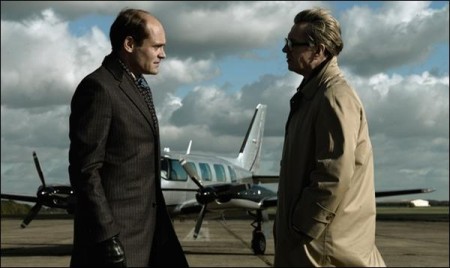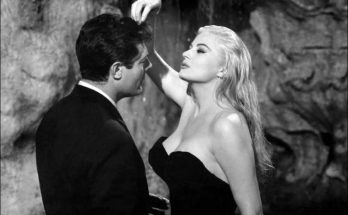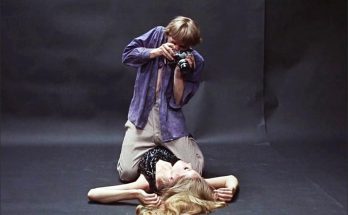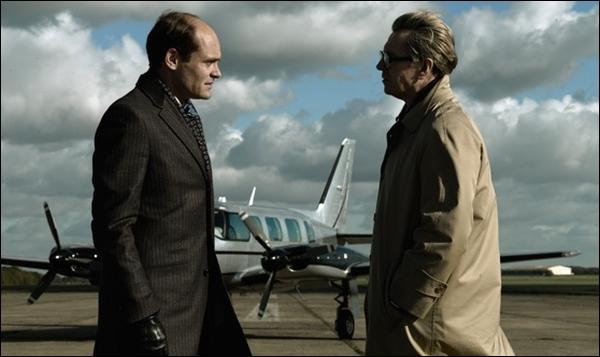The time is 1973. The Cold War of the mid-20th Century continues to damage international relations. Britain’s Secret Intelligence Service (SIS), a.k.a. MI6 and code-named the Circus, is striving to keep pace with other countries’ espionage efforts and to keep the U.K. secure. The head of the Circus, known as Control (John Hurt), personally sends dedicated operative Jim Prideaux (Mark Strong) into Hungary. But Jim’s mission goes bloodily awry, and Control is forced out of the Circus – as is his top lieutenant, George Smiley (Gary Oldman), a career spy with razor-sharp senses.
Estranged from his absent wife Ann, Smiley is soon called in to see undersecretary Oliver Lacon (Simon McBurney); he is to be rehired in secret at the government’s behest, as there is a gnawing fear that the Circus has long been compromised by a double agent, or mole, working for the Soviets and jeopardizing England. Supported by younger agent Peter Guillam (Benedict Cumberbatch), Smiley parses Circus activities past and present. In trying to track and identify the mole, Smiley is haunted by his decades-earlier interaction with the shadowy Russian spy master Karla.
The mole’s trail remains cold until maverick field agent Ricki Tarr (Tom Hardy) unexpectedly contacts Lacon. While undercover in Turkey, Ricki has fallen for a betrayed married woman, Irina (Svetlana Khodchenkova), who claims to possess crucial intelligence. Separately, Smiley learns that Control narrowed down the list of mole suspects to five men. They are the ambitious Percy Alleline (Toby Jones), whom he had code-named Tinker; suavely confident Bill Haydon (Colin Firth), dubbed Tailor; stalwart Roy Bland (Ciarán Hinds), called Soldier; officious Toby Esterhase (David Dencik), dubbed Poor Man; and – Smiley himself.
While considering directors for the movie, Tim Bevan fielded a phone call from Tomas Alfredson, the Swedish filmmaker who had caught the world film community’s attention with his striking and empathetic feature Let the Right One In. Alfredson had heard that Working Title would be making Tinker, Tailor, Soldier, Spy, and so he initiated contact. A meeting was arranged. Bevan remembers, “I was expecting some trendy young Swede to come through the door. But this very big man, about my age, came in and he was quite quiet.
“I asked for his take on the material. He said, ‘Well, I think that all of the musclebound guys, they go and they join the army. And the nerds, they are the spies.’ I thought, ‘Now, there’s an angle…’”
Robyn Slovo notes, “Here is a group of men who, on the one hand, are united in their place of work, and on the other are all separate individuals who harbor separate secrets – and are all looking and watching each other. We’re spying on a spy world. This would naturally appeal to a very visually-driven director, but there would have to be a feel for the story as well.”
Bevan adds, “We were looking for a directorial vision from a confident filmmaker to firmly guide the audience through the narrative of this complex story. Tomas was a bit of an unlikely candidate, but le Carré saw Let the Right One In and said, ‘Go with him.’
“The thing about period films is that the only thing ‘period’ about them should be the look. This allows for the viewer to have more of an emotional response. The director must create a world to journey through with the audience. These approaches characterized Tomas’ work on Let the Right One In, and now would again on Tinker, Tailor, Soldier, Spy.”
Slovo notes, “Tomas is Swedish and this is an English story, so that brings an objective perspective; we don’t go down the path of the overly familiar take.”
Certainly for le Carré, who had worked with Brazilian director Fernando Meirelles on the successful film version of The Constant Gardener, having a foreign filmmaker at the helm was a plus. The author says, “As on The Constant Gardener, I thought that what we would lose in parochial Englishness we would gain in internationalism and universality. Many of the structures of British society are replicated all over the world. I think Tomas as a filmmaker brings amazing originality, and very strong onscreen ‘handwriting.’”
Alfredson remembered the 1979 miniseries, which he had watched growing up in Sweden. He recalls, “When it aired, streets were empty; everybody was watching it. The story concerned something going on that was involving and affecting the whole world, but it had nothing of the 007 style about it — it was quite different from that, almost everyday, which made it extremely interesting.”
The director’s subsequent research into the era only intrigued him all the more. He elaborates, “What many people don’t now realize is that, as a spy, you did your assignment and that was all you knew. It could be, working in a shop in Vienna for a year and writing down who goes in and who goes out of a door on the other side of the street; to do that, you would have had to learn German for months prior.
“Then you would get back and never know what it meant, but you had served your country. All you could say to family and friends was that you had been on a business trip. If you’re in such an existence too long, you can fall prey to lies and paranoia. What does it do to your morale?”
The director concedes that because le Carré’s novel “is such a cornerstone of British literature”, he did feel some pressure in taking on the assignment. “It’s scary to handle material of this magnitude,” he admits.
“But you have to put that aside. If you are daring to do the job, you need to have strong connections to the material. I suppose I understand George Smiley’s soul in some way. When I first met John le Carré, there was a very strong personal connection. It felt like I understood what he was expecting from a film, and I was very surprised that was so generous and open. Not only in terms of sharing information and details with us for hours at a time, but also in terms of how he said, ‘Make interesting reflections of yourself.’ So I set out to try to make the images I saw in the book, and the humanity of the characters, come to the screen.”
After Peter Morgan had written a draft, Bevan found that the screenwriter “wasn’t available to keep going with the script, so we went to the team of Bridget O’Connor and Peter Straughan to write the screenplay adaptation. They worked very closely with Tomas for almost a year.”
Le Carré offers, “When I read Bridget and Peter’s first draft, it was a piece of dramatic and intellectual architecture that I could admire. I knew I couldn’t do something like that. At that point, I joined their work. It was not the film of the book; it was the film of the film. I think they did it splendidly.
“The greatest compliment all of the filmmakers paid to the book, as far as I’m concerned, was to make their own film from it. I was there as a resource, that’s all; I knew the material very well, and I offered what mental agility I have.”
“Their first draft was so promising,” remembers Slovo. “It helped make the development process very quick, and we started casting the movie by the time there was a third draft.”
Staying faithful to the period when it was written and published, the feature unfolds primarily in 1973 (progressing into 1974). Bevan adds, “The team’s script represented the book, retained the complications of the book, and had integrity at its heart. As a producer, you’re always looking for a compelling story, compelling emotion, and compelling characters. Their script had those elements, and it is very much their script that was shot.”
The script was now in the hands of a director making his first English-language film. Alfredson muses, “I’m unpredictable with my career moves; something comes up and I’ll feel, ‘This is the right thing to do next.’
“This picture is certainly a big step for me. I’ve been doing films and television for almost 30 years, so it was a big change to work in a different language. But everyone was so helpful.”
Particularly so, he says, were the eyes and ears of the female half of the screenwriting team, Bridget O’Connor, who passed away just as filming began and to whom the finished film is dedicated. Alfredson reflects, “Since I wasn’t interested in doing it like the usual thriller, talking with Bridget about her interpretation and having her female eye on it was important. These men had to make use of their feminine sides and abilities. I needed that different perspective, and she helped me get it.”
In his research, Alfredson was fascinated to learn that “there was a lot of homosexuality in this world. At that time in Britain, it was not accepted, and there were spies and agents who could not be open about their sexuality because they could then be blackmailed. So Bridget and Peter were able to delve into this in the adaptation.”
To the director, the story particularly resonates and reverberates with “eternal and dramatic questions of friendship, betrayal, and loyalty.
“Also, as we’ve now reached a little distance from the Cold War era, we can look at what happened; were the bad guys truly the bad guys? We should know about our shared history, especially this piece that still echoes today.”
Alfredson muses, “There’s also the factor of, ‘I know something that you don’t know.’ Say that, or hint that, to someone, and you’ve got their attention and are getting into their head.”
Related Link: Read the Full Production Notes for Tinker Tailor Soldier Spy
Views: 249




